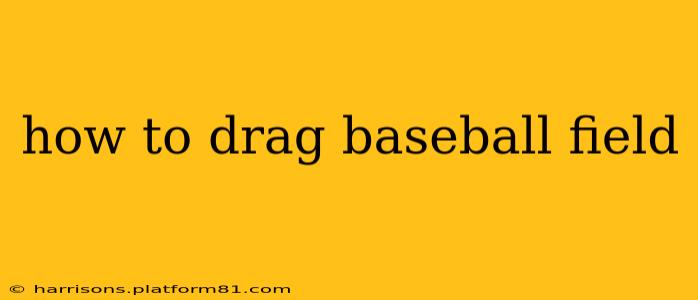How to Drag a Baseball Field: Maintaining a Championship-Level Playing Surface
Maintaining a pristine baseball field requires consistent effort, and dragging—or grooming—the infield is a crucial part of that process. Proper dragging ensures a consistent, safe, and fast playing surface. This guide will cover the techniques and tools necessary for effective infield dragging.
What Equipment Do I Need to Drag a Baseball Field?
The equipment you'll need depends on the size of the field and the type of soil, but generally includes:
-
Drag Mat (or Drag Harrow): This is the heart of the operation. Drag mats come in various sizes and materials, from lightweight nylon to heavier-duty options. The choice depends on the soil type and the amount of material to be moved. Heavier mats are better for moving larger amounts of loose material.
-
Tow Vehicle (ATV, Tractor, or even a strong person): Something to pull the drag mat is essential. ATVs are popular for their maneuverability, while tractors offer more power for larger fields. For very small fields, it's possible to pull a smaller drag manually, but this is labor-intensive.
-
Water Source (Hose or Water Tank): Moisture is key for optimal dragging. The soil should be damp but not soaked. A water source is needed to adjust the moisture content before and during dragging.
-
Smooth-Toothed Rake: Used to remove clumps and level out the surface after dragging.
-
Leveling Tools (Hand Rake or Drag): This is used to level out any uneven areas after dragging.
What is the Best Time to Drag a Baseball Field?
The ideal time to drag a field is after it has been watered and is slightly damp but not muddy. This allows the soil to be moved and shaped effectively without creating ruts or damage. Avoid dragging when the field is overly dry or saturated. Ideally, drag the field regularly, even if only lightly, to keep the surface even and prevent excessive wear.
How Often Should I Drag a Baseball Field?
The frequency of dragging depends on several factors: the amount of use the field gets, the type of soil, and weather conditions. A heavily used field might need dragging daily, while a less used field might only need it once or twice a week. Regular light dragging is often preferred to infrequent heavy dragging.
What are Different Types of Dragging Techniques?
There are several techniques used depending on the specific needs of the field:
-
Light Dragging: Used for maintaining a smooth surface and removing loose debris. This is typically done with a lighter drag mat and involves multiple passes in different directions.
-
Heavy Dragging: Used to redistribute large amounts of loose material or to reshape a severely uneven surface. This involves using a heavier drag mat and may require several passes.
-
Directional Dragging: This technique involves dragging the mat in specific directions to achieve a desired effect, such as creating a smooth playing surface or removing clumps in a particular area.
How Do I Prevent Ruts and Damage When Dragging?
Proper moisture is critical. Avoid dragging on excessively dry or wet soil. Overlap passes slightly to ensure even coverage and prevent the formation of ruts. Use a drag mat appropriate for the soil type and the amount of material to be moved. Regular maintenance and attention to detail prevent long-term damage.
What are the Benefits of Proper Infield Dragging?
Proper infield dragging offers many benefits, including:
- Improved Playability: A smooth, even surface makes for a better playing experience.
- Reduced Injuries: A consistently maintained field reduces the risk of ankle sprains and other injuries.
- Enhanced Appearance: A well-maintained field looks professional and well-kept.
- Improved Drainage: Proper dragging can help improve drainage, especially when combined with proper field maintenance.
By following these guidelines and using the appropriate techniques, you can ensure your baseball field remains in top condition throughout the season, providing a safe and enjoyable playing experience for all. Remember that experience and observation are key to mastering the art of infield dragging.
